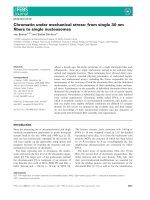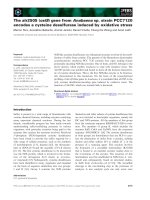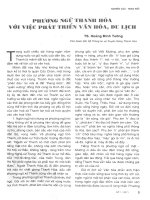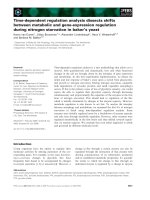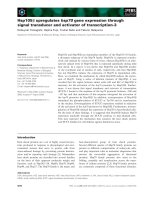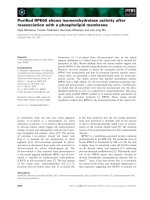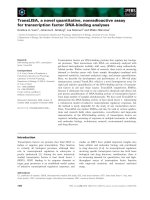Tài liệu Báo cáo khoa học: Hsp105b upregulates hsp70 gene expression through signal transducer and activator of transcription-3 pdf
Bạn đang xem bản rút gọn của tài liệu. Xem và tải ngay bản đầy đủ của tài liệu tại đây (969.13 KB, 11 trang )
Hsp105b upregulates hsp70 gene expression through
signal transducer and activator of transcription-3
Nobuyuki Yamagishi, Hajime Fujii, Youhei Saito and Takumi Hatayama
Department of Biochemistry & Molecular Biology, Division of Biological Sciences, Kyoto Pharmaceutical University, Japan
Keywords
heat shock protein; Hsp70; Hsp105b;
nuclear localization; STAT3
Correspondence
T. Hatayama, Department of Biochemistry &
Molecular Biology, Division of Biological
Sciences, Kyoto Pharmaceutical University,
5 Nakauchi-cho, Misasagi, Yamashina-ku,
Kyoto 607-8414, Japan
Fax: +81 75 595 4758
Tel: +81 75 595 4653
E-mail:
(Received 14 May 2009, revised 3 August
2009, accepted 7 August 2009)
doi:10.1111/j.1742-4658.2009.07311.x
Hsp105a and Hsp105b are mammalian members of the Hsp105 ⁄ 110 family,
a divergent subgroup of the Hsp70 family. Hsp105a is expressed constitutively and induced by various forms of stress, whereas Hsp105b is an alternatively spliced form of Hsp105a that is expressed specifically during mild
heat shock. In a report, it was shown that Hsp105a and Hsp105b localize
to the cytoplasm and of nucleus of cells, respectively, and that Hsp105b,
but not Hsp105a, induces the expression of Hsp70 in mammalian cells.
Here, we examined the mechanism by which Hsp105b induces the expression of Hsp70. Using a series of deletion mutants of Hsp105b, it was
revealed that the region between amino acids 642 and 662 of Hsp105b is
necessary for the activation of the hsp70 promoter by Hsp105b. Furthermore, it was shown that signal transducer and activator of transcription
(STAT)-3 bound to the sequence of the hsp70 promoter between )206 and
)187 bp, and that mutations of this sequence abrogated the activation of
the hsp70 promoter by Hsp105b. In addition, overexpression of Hsp105b
stimulated the phosphorylation of STAT3 at Tyr705 and its translocation
to the nucleus. Downregulation of STAT3 expression resulted in reduction
of the activation of the hsp70 promoter by Hsp105b. Furthermore, downregulation of Hsp105b reduced the expression of Hsp70 in heat-shocked cells.
On the basis of these findings, it is suggested that Hsp105b induces Hsp70
expression markedly through the STAT3 pathway in heat-shocked cells.
This may represent the mechanism that connects the heat shock protein
and STAT families for cell defense against deleterious stress.
Introduction
Heat shock proteins are a set of highly conserved proteins produced in response to physiological and environmental stresses that serve to protect cells from
stress-induced damage by preventing protein denaturation and ⁄ or repairing such damage [1]. Mammalian
heat shock proteins are classified into several families
on the basis of their apparent molecular weight and
function, such as Hsp105 ⁄ 110, Hsp90, Hsp70, Hsp60,
Hsp40, and Hsp27. The Hsp70 family is the major and
best-characterized group of heat shock proteins.
Several different species of Hsp70 family proteins are
present in different compartments of eukaryotic cells,
and play important roles as molecular chaperones that
prevent the irreversible aggregation of denatured
proteins. Hsp70 family proteins also assist in the
folding, assembly and translocation across the membrane of cellular proteins [2,3]. Hsp70 family proteins
are commonly composed of three functional domains:
Abbreviations
DOX, doxycycline; HSE, heat shock element; HSF, heat shock factor; INFa, interferon a; JAK, Janus kinase; NLS, nuclear localization signal;
siRNA, small interfering RNA; STAT, signal transducer and activator of transcription.
5870
FEBS Journal 276 (2009) 5870–5880 ª 2009 The Authors Journal compilation ª 2009 FEBS
N. Yamagishi et al.
the highly conserved N-terminal ATPase domain binds
ADP ⁄ ATP, and can hydrolyze ATP; the central
b-sheet domain directly binds peptide substrates; and
the C-terminal a-helix domain regulates substrate
binding [4–6].
Hsp105a and Hsp105b are mammalian members of
the Hsp105 ⁄ 110 family, a divergent subgroup of the
Hsp70 family. Hsp105a is expressed constitutively and
induced by various forms of stress, whereas Hsp105b
is an alternatively spliced form of Hsp105a that is
expressed specifically during mild heat shock [7–9].
These proteins suppress the aggregation of denatured
proteins caused by heat shock in vitro, as does
Hsp70 ⁄ Hsc70, but they have yet to be found to have
refolding activity [10]. In addition, Hsp105a and
Hsp105b were suggested to function as a substitute for
Hsp70 family proteins to suppress the aggregation of
denatured proteins in cells under severe stress, in which
the cellular ATP level decreases markedly [11]. In a
preceding report, we showed that Hsp105a localizes in
the cytoplasm of mammalian cells, whereas Hsp105b
localizes in the nucleus [12]. Furthermore, Hsp105b,
but not Hsp105a, induces the expression of Hsp70 in
mammalian cells [13].
In this study, we showed that Hsp105b-mediated
Hsp70 induction was regulated by signal transducer
and activator of transcription (STAT)-3 but not heat
shock factors (HSFs). Furthermore, Hsp105b seemed
to upregulate Hsp70 expression in heat-shocked cells.
Results
Mechanism of Hsp105b-induced Hsp70 expression
As Hsp105b(D642–698), which lacked the region
between amino acids 642 and 698, also failed to induce
the luciferase activity, the region between amino acids
642 and 662 of Hsp105b seemed to be necessary for
activation of the hsp70 promoter. Furthermore,
Hsp105bmNLS, in which several amino acids in the
nuclear localization signal (NLS) sequence of Hsp105b
were replaced, also failed to activate the hsp70
promoter, as described previously [13].
We next examined the cellular localization of the
deletion mutants of Hsp105b in COS-7 cells by indirect
immunofluorescence, using antibody against myc-tag.
As shown in Fig. 1C, Hsp105b localized to the nucleus
of cells, but Hsp105bmNLS, which failed to activate
the hsp70 promoter, localized to the cytoplasm of cells.
In addition, Hsp105b(1–756), which activates the hsp70
promoter like Hsp105b, localized mainly to the nucleus
of cells, whereas Hsp105b(1–698), Hsp105b(1–677),
and Hsp105b(1–662), which activate the hsp70 promoter to approximately 60% of the extent to which it
is activated by Hsp105b, localized not only to the
nucleus but also to the cytoplasm of cells. However,
Hsp105b(1–641), Hsp105b(1–591), and Hsp105b(D642–
698), which failed to activate the hsp70 promoter, also
localized to the nucleus and cytoplasm. Interestingly,
Hsp105b(1–564) localized mainly to the nucleus of
cells, like Hsp105b, although it failed to activate the
hsp70 promoter. These results suggest that the nuclear
localization of Hsp105b was necessary but not sufficient for the Hsp105b-induced expression of the hsp70
gene.
Nuclear localization of Hsp105b is necessary
but not sufficient for activation of the hsp70
promoter
The promoter region between )206 and )187 bp
of the hsp70 gene is essential for activation of
the hsp70 promoter by Hsp105b
In preceding reports, we have shown that Hsp105b, but
not Hsp105a, localizes to the nucleus and induces the
expression of Hsp70 in mammalian cells [12,13]. To elucidate the mechanism by which Hsp105b induces the
expression of Hsp70, a series of plasmids that expressed
C-terminal deletion mutants of Hsp105b were cotransfected into COS-7 cells with the reporter plasmid
pGL70()2616) (Fig. 1A). As shown in Fig. 1B,
Hsp105b(1–756), lacking the C-terminal 58 amino
acids, showed an approximately 10-fold induction in
luciferase activity, similar to full-length Hsp105b.
Furthermore, Hsp105b(1–698), Hsp105b(1–677) and
Hsp105b(1–662) induced approximately 60% of the
luciferase activity as compared with the control. However, Hsp105b(1–641), Hsp105b(1–591), and Hsp105b
(1–564), lacking more than the C-terminal 173 amino
acids of Hsp105b, failed to induce luciferase activity.
To identify the hsp70 promoter region that is necessary
for the induction of Hsp70 by Hsp105b, a series of
hsp70 5¢-promoter deletion-luciferase constructs were
generated and transiently transfected into COS-7 cells
with the Hsp105b expression plasmid (Fig. 2A). As
shown in Fig. 2B, although Hsp105b enhanced the
activity of hsp70 promoter deleted up to )218 bp,
further deletion of the hsp70 promoter up to )194 bp
abolished the responsiveness to Hsp105b. Furthermore,
we found two putative heat shock elements (HSEs)
(5¢-NGAAN-3¢) and two putative STAT3-binding elements (5¢-CTGGRA-3¢) in the region between )206 and
)187 bp of the hsp70 promoter through transcription
factor database (TRANSFAC; http: ⁄ ⁄ www.biobaseinternational.com ⁄ pages ⁄ index) searches (Fig. 2A).
When the pGL70(–218)mut construct with five
mutated bases within these elements were transiently
FEBS Journal 276 (2009) 5870–5880 ª 2009 The Authors Journal compilation ª 2009 FEBS
5871
Mechanism of Hsp105b-induced Hsp70 expression
A
N. Yamagishi et al.
B
C
5872
FEBS Journal 276 (2009) 5870–5880 ª 2009 The Authors Journal compilation ª 2009 FEBS
N. Yamagishi et al.
transfected into COS-7 cells with the Hsp105b expression plasmid, the activation of the hsp70 promoter by
Hsp105b was not observed (Fig. 2B). On the other
hand, after deletion of the sequence of the hsp70 promoter to )194 bp, responsiveness to heat shock was
retained, and the heat inductivity of the hsp70 promoter was dependent on the length of the 5¢-flanking
sequence of the hsp70 gene (Fig. 2C). Thus, Hsp105b
seemed to activate the hsp70 promoter by a mechanism
different from the heat-induced activation of hsp70
promoter, and the region between )206 and )187 bp
of the hsp70 promoter is necessary for Hsp105binduced expression of the hsp70 gene.
STAT3, but not HSF1, binds to the region
between )206 and )187 bp of the hsp70
promoter
Next, we investigated protein binding to the region
between )206 and )187 bp of the hsp70 promoter,
using a biotin-mediated oligonucleotide pull-down
assay (Fig. 3A). When the extracts from the cells overexpressing Hsp105b were incubated with a biotinylated
oligonucleotide probe, GL70, containing the sequence
from )212 to )185 bp of the hsp70 promoter, STAT3
was found to bind to the GL70 oligonucleotide but not
the GL70mt oligonucleotide, which was mutated in the
HSF1 ⁄ STAT3 consensus sequences. On the other hand,
HSF1 binding to GL70 or GL70mt was not observed.
To further examine whether STAT3 bound to the
hsp70 promoter in vivo, chromatin immunoprecipitation analyses were performed using HeLa-tet ⁄ Hsp105b
cells (Fig. 3B). In the cells incubated with doxycycline
(DOX), the chromatin containing the hsp70 promoter
fragment was not coimmunoprecipitated with STAT3
antibody. However, when Hsp105b was overexpressed,
the binding of STAT3 to the region between )272 and
)13 bp of the hsp70 promoter was observed using
STAT3 antibody, whereas the hsp70 promoter fragment was not detected using normal rabbit IgG. However, STAT3 did not bind to the region between )1860
and )1656 bp of the hsp70 promoter. In addition, the
Mechanism of Hsp105b-induced Hsp70 expression
chromatin containing the hsp70 promoter fragment
was pulled down by acetylated histone H4 antibody,
regardless of Hsp105b overexpression, suggesting that
Hsp105b did not affect the basal histone H4 acetylation of the hsp70 promoter. These results suggested
that STAT3 binds directly to the region between )206
and )187 bp of the hsp70 promoter in vitro and
in vivo, resulting in the induction of Hsp70 expression.
STAT3 is required for the induction of hsp70
promoter activity by Hsp105b
To further demonstrate that STAT3 plays essential
roles in the activation of the hsp70 promoter by
Hsp105b, STAT3 expression was downregulated by a
small interfering RNA (siRNA) method. In the experiment, we used human HEK293 cells in which STAT3
expression was effectively downregulated by the
STAT3 siRNA, and monkey COS-7 cells in which it
was not. The transfection of STAT3 siRNA decreased
STAT3 expression by up to approximately 25% in
the cells, and the Hsp105b-mediated hsp70 promoter
activation was significantly suppressed by the STAT3
siRNA but not by control siRNA (Fig. 4). These
results further suggested that STAT3 mediates
Hsp105b-induced expression of the hsp70 gene.
STAT3 is activated by tyrosine phosphorylation at
Tyr705, which induces dimerization, nuclear translocation, and DNA binding [14–16]. We next examined
whether Hsp105b stimulated the phosphorylation of
STAT3 at Tyr705 using antibody against phosphoSTAT3 (Tyr705). When HeLa-tet ⁄ Hsp105b cells were
treated with interferon a (INFa), an activator of the
Janus kinase (JAK)–STAT pathway, STAT3 was phosphorylated at Tyr705 and translocated into the nucleus
in cells incubated with or without DOX (Fig. 5A,B).
Furthermore, when Hsp105b was overexpressed in
HeLa-tet ⁄ Hsp105b cells, STAT3 was phosphorylated
and translocated into the nuclei without INFa treatment (Fig. 5A,B), suggesting that Hsp105b stimulates
the phosphorylation of STAT3 at Tyr705 and translocation into the nuclei of cells.
Fig. 1. The region between amino acids 642 and 662 of Hsp105b is necessary for activation of the hsp70 promoter by Hsp105b. (A) Schematic representation of a series of C-terminal deletion mutants of Hsp105b. The asterisk in the Hsp105bmNLS mutant indicates the location
of the mutated NLS sequence. (B) The expression plasmids for Hsp105b and its deletion mutants were cotransfected with the
pGL70()2616) reporter construct into COS-7 cells, and luciferase activities were measured. To estimate the transfection efficiency of these
plasmids, the levels of a series of C-terminal deletion mutants of Hsp105b and a-tubulin were determined by western blotting using antibodies against myc-tag and a-tubulin, respectively. Relative activity is expressed as ratio to that of cells cotransfected with pGL70()2616) plasmid and pcDNA3.1(+)myc ⁄ His vector. Values represent the means ± standard deviations of four independent experiments, and asterisks
indicate significant differences (*P < 0.01, **P < 0.05). (C) The expression plasmids for Hsp105b and its deletion mutants were transfected
into COS-7 cells. At 48 h after transfection, cells were stained with Hoechst 33342 (blue), and the intracellular distribution of Hsp105b and
its mutants was determined by indirect immunofluorescence microscopy using antibody against myc-tag (red).
FEBS Journal 276 (2009) 5870–5880 ª 2009 The Authors Journal compilation ª 2009 FEBS
5873
Mechanism of Hsp105b-induced Hsp70 expression
N. Yamagishi et al.
A
B
C
Fig. 2. The hsp70 promoter region between )218 and )194 bp is required for activation of the hsp70 promoter by Hsp105b. (A) Schematic
representation of 5¢-serial deletions of the hsp70 promoter reporter constructs. (B) The expression plasmid for Hsp105b was cotransfected
with the constructs in (A), and luciferase activities were measured. (C) COS-7 cells were transfected with the constructs in (A). At 48 h after
transfection, cells were treated at 45 °C for 10 min, and then maintained at 37 °C for 8 h. Luciferase activities were then measured. Relative
activities in (B) and (C) are expressed as ratios to that of cells transfected with pGL70()2616) plasmid and pcDNA3.1(+)myc ⁄ His vector.
Values represent the means ± standard deviations of three independent experiments, and the asterisks represent significant differences
at P < 0.01.
Downregulation of Hsp105 reduces the induction
of Hsp70 expression during heat shock
To elucidate the physiological role of Hsp105b-mediated regulation of Hsp70 expression, we examined
5874
whether Hsp105 affects Hsp70 expression during heat
shock at 42 °C, at which temperature Hsp105b is
induced. As shown in Fig. 6, when HeLa-tet ⁄ Hsp105b
cells were treated at 42 °C for 5 h, Hsp105b was
induced at 5 h, and the expression of Hsp70 increased
FEBS Journal 276 (2009) 5870–5880 ª 2009 The Authors Journal compilation ª 2009 FEBS
N. Yamagishi et al.
Mechanism of Hsp105b-induced Hsp70 expression
A
A
B
B
Fig. 3. STAT3, but not HSF1, binds to the region between )206
and )187 bp of the hsp70 promoter. (A) HeLa-tet ⁄ Hsp105b cells
were grown in medium without DOX for a period of 48 h. Extracts
from these cells were incubated with biotinylated GL70 or GL70mt
oligonucleotides. After unbound proteins were removed by washing, proteins bound to the oligonucleotides were eluted with
excess biotin and detected by western blotting, using antibody
against STAT3 or HSF1. The input represented 5% of the protein
used in the pull-down assay. (B) Chromatin immunoprecipitation
analysis was performed with chromatin extracts from HeLatet ⁄ Hsp105b cells grown in medium with or without DOX for a
period of 48 h. DNAs from chromatins immunoprecipitated with
an antibody against STAT3, acetylated histone H4 or normal rabbit
IgG were amplified by PCR with two sets of specific primers for
the hsp70 promoter. The input represents 5% of the material used
in the chromatin immunoprecipitation assays. Similar results were
obtained with two independent experiments.
gradually and markedly at 5 h. However, when
Hsp105 expression was downregulated by Hsp105 siRNA, accumulation of Hsp70 at 5 h was suppressed
during heat shock at 42 °C. Furthermore, the heatinduced Hsp70 was reduced by the downregulation of
STAT3 (Fig. 7). Thus, Hsp105b seemed to enhance the
expression of Hsp70 during mild heat shock conditions.
Discussion
We have shown that Hsp105b, but not Hsp105a, localizes to the nucleus and induces the expression of
Fig. 4. STAT3 is required for activation of the hsp70 promoter by
Hsp105b. The expression plasmid for Hsp105b was cotransfected
with pGL70()2616) plasmid and STAT3 or control siRNA into
HEK293 cells. (A) At 48 h after transfection, cells were harvested,
and STAT3, Hsp105b and a-tubulin were detected by western blotting, using the respective antibodies. (B) Luciferase activity was
measured as hps70 promoter activity. Relative activity is expressed
as a ratio to that of cells cotransfected with control siRNA,
pGL70()2616) plasmid, and pcDNA3.1(+)myc ⁄ His vector. Values
represent the means ± standard deviations of four independent
experiments, and the asterisks indicate significant differences at
P < 0.01.
Hsp70 in mammalian cells [12,13]. Here, we examined
the mechanism by which Hsp105b induces the expression of Hsp70, and showed that Hsp105b induces the
expression of Hsp70 through the transactivation of
STAT3 in mammalian cells. Indeed, it was found that
STAT3 bound to the sequence between )206 and
)187 bp of the hsp70 promoter, and mutation of the
conserved motif for STAT3 binding in this region
abrogated activation of the hsp70 promoter by
Hsp105b. Furthermore, downregulation of STAT3
expression resulted in reduced Hsp105b-induced
expression of the hsp70 gene.
FEBS Journal 276 (2009) 5870–5880 ª 2009 The Authors Journal compilation ª 2009 FEBS
5875
Mechanism of Hsp105b-induced Hsp70 expression
N. Yamagishi et al.
A
A
B
B
C
Fig. 5. Activation of STAT3 and nuclear translocation by Hsp105b.
HeLa-tet ⁄ Hsp105b cells were incubated with or without DOX for
48 h, and were treated without or with 100 ngỈmL)1 INFa for
10 min. (A) Phosphorylated STAT3 (Tyr705) (p-STAT3), STAT3,
Hsp105, Hsp70 and a-tubulin were analyzed by western blotting,
using the respective antibodies. (B) These cells were stained with
Hoechst 33342 (blue), and the intracellular distribution of phosphorylated STAT3 was determined by indirect immunofluorescence
microscopy using antibody against phospho-STAT3 (red).
The major regulators of hsp gene expression are
HSFs, which form a multimember protein family in
vertebrates [17]. Each HSF seems to have special functions in response to distinct stimuli under normal or
stressed conditions. HSF1 is a typical transcription factor, and is responsive to various stresses, such as heat
shock [18]. Under nonstress conditions, HSF1 exists in
an inactive form as a monomer; in response to stress,
it forms homotrimers that bind to the HSEs in the
5876
Fig. 6. Hsp105b upregulates the expression of Hsp70 during mild
heat shock. (A) Hsp105 or control siRNA was transfected into
HeLa-tet ⁄ Hsp105b cells grown in medium with DOX. At 48 h after
transfection, the cells were treated at 42 °C for 5 h, and the
expression of Hsp105, Hsp70 and a-tubulin was analyzed by western blotting, using the respective antibodies. (B, C) The density of
bands was quantified by densitometry, and was corrected with the
density of a-tubulin as loading control. Relative levels of Hsp70 (B)
and Hsp105b (C) are represented as ratios of respective levels in
the cells heat-shocked at 42 °C for 5 h with transfection of control
siRNA. Values represent the means ± standard deviations of three
independent experiments, and the asterisks indicate significant
differences at P < 0.01.
promoter regions of hsp genes [19]. In addition, an
inflammatory cytokine, interleukin-6, induces the expression of Hsp70 and Hsp90b via STAT-like binding
FEBS Journal 276 (2009) 5870–5880 ª 2009 The Authors Journal compilation ª 2009 FEBS
N. Yamagishi et al.
A
B
Fig. 7. Requirement of STAT3 for the induction of Hsp70 during
mild heat shock. (A) STAT3 or control siRNA was transfected into
HeLa-tet ⁄ Hsp105b cells grown in medium with DOX. At 48 h after
transfection, the cells were treated at 42 °C for 5 h, and the
expression of STAT3, Hsp70 and a-tubulin was analyzed by western blotting, using the respective antibodies. (B) The density of
bands was quantified by densitometry, and was corrected with the
density of a-tubulin as loading control. Relative levels of Hsp70 are
represented as ratios of respective levels in the cells heat-shocked
at 42 °C for 5 h with transfection of control siRNA. Values represent the means ± standard deviations of three independent experiments, and the asterisks indicate significant differences at
P < 0.01.
sites that are located close to the HSEs in the hsp70
and hsp90b promoters. The activation of hsp promoters is mediated through the STAT3 signaling pathway
[20]. STAT1 also enhances the activation of hsp70 and
hsp90 promoters [21]. As we showed, in this study, that
STAT3 directly bound to the region between )206 and
)187 bp of the hsp70 promoter and enhanced the
expression of the hsp70 gene in the cells overexpressing
Hsp105b, STAT family proteins seem to play an
important role in the regulation of hsp gene expression.
STAT family proteins are present in a latent, monomeric form in the cytoplasm, and are activated by
specific tyrosine phosphorylation by JAK family mem-
Mechanism of Hsp105b-induced Hsp70 expression
bers. The phosphorylation of STATs leads to homodimerization or heterodimerization, and the STATs then
migrate to the nuclei of cells to activate target gene
expression [14–16]. We showed here that Hsp105b
stimulated the phosphorylation of STAT3 at Tyr705
and its translocation into the nucleus. Hsp105b seems
not to activate JAKs directly, as JAKs localize mainly
into the cytoplasm. As Hsp105a, which localizes in the
cytoplasm of cells, did not enhance the expression of
Hsp70, Hsp105b may activate unknown factor(s) in
the nucleus, which stimulate the phosphorylation of
STAT3 by JAKs. Further studies are required to
elucidate the precise mechanisms by which Hsp105b
activates STAT3.
HSP105 ⁄ 110 family proteins are suggested to prevent the aggregation of denatured proteins caused by
heat shock in vitro, as does Hsp70 ⁄ Hsc70 [10,22,23].
More recently, mammalian Hsp105 ⁄ 110 and the yeast
homologs Sse1p ⁄ 2p have been shown to act as efficient
nucleotide exchange factors for Hsp70 and its orthologs in Saccharomyces cerevisiae, Ssa1p and Ssb1p,
respectively, and enhance Hsp70-mediated chaperone
activity [24–26]. However, although HSP105 family
proteins are important components of the Hsp70 chaperone machinery, excess Hsp110 seems to have a negative effect on Hsp70-mediated chaperone activity,
owing to it accelerating substrate cycling to such an
extent that the reaction becomes unproductive for folding [25]. Hsp105b-induced expression of Hsp70 may be
important for Hsp70-mediated protein refolding by the
correction of the ratio between Hsp105 and Hsp70
chaperones in the cells. Furthermore, as Hsp105b is
necessary for the marked expression of Hsp70 under
mild heat shock conditions, Hsp105b seems to play an
important role in protection against deleterious stressors by Hsp70. Although further study will be required
to clarify the mechanisms by which Hsp105b induces
the activation of STAT3, the present findings may provide clues to the cellular function of HSP105 family
proteins in the chaperone network of mammalian cells.
Experimental procedures
Antibodies
The following antibodies were used for western blotting,
immunofluorescence, and gel shift experiments: Hsp105,
rabbit anti-(human Hsp105 IgG) [27]; Hsp70, mouse anti(human Hsp70 IgG), which only reacted with inducible
Hsp70 (clone C92F3A-5; Stressgen, Ann Arbor, MI, USA);
myc tag, mouse anti-myc IgG (Invitrogen, Carlsbad, CA,
USA); HSF1, rabbit anti-(human HSF1 IgG) (Stressgen);
STAT3, rabbit anti-(mouse STAT3 IgG) (K-15; Santa Cruz
FEBS Journal 276 (2009) 5870–5880 ª 2009 The Authors Journal compilation ª 2009 FEBS
5877
Mechanism of Hsp105b-induced Hsp70 expression
N. Yamagishi et al.
Biotechnology, Santa Cruz, CA, USA); phosphorylated
STAT3, rabbit anti-[phospho-STAT3 (Tyr705) IgG] (D3A7;
Cell Signaling Technology, Danvers, MA, USA); a-tubulin,
mouse anti-a-tubulin IgG (clone DM1A; Sigma, Saint
Louis, MI, USA).
Table 1. Primers used for construction of 5¢-serial deletions of
hsp70 promoter reporter constructs.
Plasmid
Orientation
Sequence (5¢- to 3¢)
pGL70()1194)
Sense
Antisense
Sense
Antisense
Sense
Antisense
Sense
Antisense
Sense
Antisense
Sense
Antisense
GGAGGTGGAGCAATTAGCCG
GGGTTATGTTAGCTCAGTTACAGTA
CTTTCCCCAAGTGCTCCTCCTA
GGGTTATGTTAGCTCAGTTACAGTA
TGGACGCGCGTAACCCGCAC
GGGTTATGTTAGCTCAGTTACAGTA
GCGCTGAAGCGCAGGCGGTCA
GGGTTATGTTAGCTCAGTTACAGTA
TGTCCCCTCCAGTGAATCCCAGA
GGGTTATGTTAGCTCAGTTACAGTA
ACTCTGGAGAGTTCTGAGCAG
GGGTTATGTTAGCTCAGTTACAGTA
pGL70()800)
Cells
African green monkey kidney COS-7 cells and human
embryonic kidney HEK293 cells were obtained from the
RIKEN Bioresource Center Cell Bank (Tsukuba, Japan).
HeLa-tet ⁄ Hsp105a and HeLa-tet ⁄ Hsp105b cells, which
express either mouse Hsp105a or Hsp105b by removing
DOX from the culture medium, have been described previously [28]. These cells were maintained in DMEM supplemented with 10% fetal bovine serum at 37 °C with 95% air
and 5% CO2.
pGL70()298)
pGL70()218)
pGL70()194)
peroxidase-conjugated anti-rabbit IgG or anti-mouse IgG,
and the antibody–antigen complexes were detected using a
western blot luminol reagent (Santa Cruz Biotechnology).
Plasmids
The expression plasmids for mouse Hsp105a, Hsp105b and
a mutant with substitutions in the NLS or a series of
C-terminal deletion mutants of Hsp105b in mammalian
cells have been described previously [12,13,29]. The construction of the reporter plasmid pGL70()2616), which contains
the firefly luciferase cDNA driven by a human hsp70 promoter sequence from )2616 to +150, has been described
previously [13]. A series of 5¢-deletions of the human hsp70
promoter sequence were generated by self-ligation of the
DNA sequence made by PCR, with pGL70()2616) as the
template DNA and a specific set of primers (Table 1). The
substitution construct of pGL70()218) was made using a
QuickChange site-directed mutagenesis kit (Stratagene, La
Jolla, CA, USA), according to the manufacturer’s instructions. The following oligonucleotides were used as primers
for mutagenesis: 5¢-CAG AAC TCT CCA GAG TCT GAT
GAG ATC TAC TGG AGG GGA CAG GGT T-3¢ and
5¢-AAC CCT GTC CCC TCC AGT AGA TCT CAT
CAG ACT CTG GAG AGT TCT G-3¢ (substituted nucleotides underlined).
Western blotting
Cells (5 · 105 cells per 35 mm diameter dish) were lysed
with 0.1% SDS and boiled for 5 min. Aliquots (20 lg of
protein) of cell extracts in SDS sample buffer (62.5 mm
Tris ⁄ HCl, pH 6.8, 10% glycerol, 2% SDS, 5% 2-mercaptoethanol, 0.00125% bromophenol blue) were subjected to
SDS ⁄ PAGE, and then transferred to nitrocellulose membranes by electrotransfer. The membranes were blocked
with 5% skimmed milk in Tris-buffered saline (20 mm
Tris ⁄ HCl, pH 7.6, 137 mm NaCl) containing 0.1% Tween20, and incubated with the indicated primary antibodies.
Then, the membranes were incubated with horseradish
5878
pGL70()405)
Measurement of hsp70 promoter activity
For the transfection of reporter constructs, COS-7 cells in
24-well plates (7 · 104 cells per well) were grown and
washed twice with Opti-MEM. The cells were then transfected with 1.5 lg of reporter plasmid and 0.75 lg of the
expression vector for Hsp105b or its deletion constructs by
lipofection, using DMRIE-C reagent according to the manufacturer’s instructions (Invitrogen). At 48 h after transfection, the cells were lysed with the cell culture lysis reagent
(Promega, Madison, WI, USA), and aliquots of the cell
extracts were subjected to measurement of luciferase activity, as described previously [11]. The protein concentration
of the cell lysates was also determined, to normalize for
protein content. For the knockdown of STAT3 expression,
10 pmol of the STAT3 siRNA (Santa Cruz Biotechnology)
or RISC-free control siRNA (Dharmacon, Chicago, IL,
USA) was cotransfected into HEK293 cells with 1.5 lg of
reporter plasmid and 0.75 lg of the expression vector
for Hsp105b, using Lipofectamine 2000, according to the
manufacturer’s instructions (Invitrogen).
Indirect immunofluorescence
Cells grown on collagenized coverslips (2 · 104 cellsỈcm)2 in
24-well plates) were fixed with 4% paraformaldehyde for
30 min at room temperature and permeabilized with icecold methanol for 10 min. After being washed twice with
NaCl ⁄ Pi, the cells were incubated with blocking solution
(NaCl ⁄ Pi containing 5% BSA) at 37 °C for 1 h. Then, the
cells were incubated with mouse anti-myc Ig (1 : 100) or
rabbit anti-phospho-STAT3 (Tyr705) IgG for 1–2 h at
37 °C. After multiple washes with NaCl ⁄ Pi, the cells were
FEBS Journal 276 (2009) 5870–5880 ª 2009 The Authors Journal compilation ª 2009 FEBS
N. Yamagishi et al.
incubated with rhodamine-conjugated anti-mouse IgG or
rhodamine-conjugated anti-rabbit IgG (1 : 50; Molecular
Probes, Eugene, OR, USA) for 1–2 h at 37 °C, and stained
with 10 lm Hoechst 33342 for 10 min in the dark. After
multiple washes with NaCl ⁄ Pi, the cells were observed using
a confocal laser scanning microscope (LSM410; Zeiss, Jena,
Germany).
Biotin-mediated oligonucleotide pull-down assay
Whole cell extracts were prepared by lysing cells with
extraction buffer as described previously [30]. Two milligrams of whole cell extract was incubated with 0.5 nmol of
biotinylated double-stranded oligonucleotide (GL70, 5¢-biotin-CTC CAG TGA ATC CCA GAA GAC TCT GGA
G-3¢; GL70mt, 5¢-biotin-CTC CAG TAG ATC TCA AGA
GAC TCT GGA G-3¢) in binding buffer [50 mm Tris ⁄ HCl,
pH 7.8, 100 mm NaCl, 1.5 mm MgCl2, 1 mm EDTA, 0.1%
NP-40, 10% (v ⁄ v) glycerol, 0.5 mgỈmL)1 salmon sperm
DNA] at 4 °C for 30 min. The samples were precleared
with CL-4B Sepharose at 4 °C for 30 min, and the remaining DNA was precipitated with 30 lL of a 50% slurry of
Ultralink streptavidin gel (Pierce, Rockford, IL, USA) at
4 °C for 1 h. Bound fractions were washed five times with
binding buffer, and DNA-bound proteins were eluted with
binding buffer containing 1 mgỈmL)1 biotin; this was followed by SDS ⁄ PAGE and western blotting.
Chromatin immunoprecipitation
HeLa-tet ⁄ Hsp105b cells were grown in medium with or
without DOX for a period of 48 h and subjected to chromatin immunoprecipitation analysis. Cells (5 · 107 cells)
were cross-linked with a final concentration of 1% formaldehyde for 8 min at room temperature, and this was
followed by quenching with a final concentration of 0.25 m
glycine. The cell pellets were then collected by centrifugation (450 g, 4 °C, 5 min) and washed three times with lysis
buffer (10 mm Tris ⁄ HCl, pH 7.5, 10 mm NaCl, 3 mm
MgCl2, 0.5% NP-40). The lysates were then sonicated on
ice to generate chromatin fragments with an average DNA
length of 500 bp. Immunoprecipitation was performed after
preclearing with salmon sperm DNA saturated protein
A–agarose beads at 4 °C overnight using anti-mouse STAT3
IgG (K-15; Santa Cruz Biotechnology), acetylated histone
H4 serum (positive control; #06-866; Upstate Biotechnology,
Lake Placid, NY, USA), or normal rabbit IgG (negative control). The immunocomplexes were washed three times in buffer A (50 mm Hepes ⁄ KOH, pH 7.5, 1 mm EDTA, 1%
Triton X-100, 0.1% sodium deoxycholate, 0.1% SDS) containing 150 mm NaCl, twice in buffer A containing 500 mm
NaCl, twice in buffer B (10 mm Tris ⁄ HCl, pH 8.0, 250 mm
LiCl, 1 mm EDTA, 0.5% NP-40, 0.1% sodium deoxycholate), and finally once in TE buffer (10 mm Tris ⁄ HCl, pH
8.0, 1 mm EDTA). The immunoprecipitated chromatin was
Mechanism of Hsp105b-induced Hsp70 expression
then eluted with elution buffer (50 mm Tris ⁄ HCl, pH 7.5,
10 mm EDTA, 1% SDS), and DNA–protein cross-links were
removed by incubating with a final concentration of
2 mgỈmL)1 pronase at 65 °C for 6 h. Then, DNA was purified using a QIAquick PCR Purification Kit (Qiagen, Hilden,
Germany). Immunoprecipitated DNA and input samples
obtained prior to immunoprecipitation were analyzed by
PCR (35 cycles of 94 °C for 15 s, 60 °C for 15 s, and 72 °C
for 30 s), using a set of specific primers for the human hsp70
gene between )272 and )13 (forward, 5¢-CCA TGG AGA
CCA ACA CCC T-3¢; reverse, 5¢-CCC TGG GCT TTT
ATA AGT CGT-3¢), or the human hsp70 gene between
)1860 and )656 (forward, 5¢-TCT ATC TCT CGA TGG
ATA CAG A-3¢; reverse, 5¢-AGG ACA GTA GAA TTA
GGT CAC T-3¢).
Knockdown of Hsp105a and Hsp105b
The double-stranded RNA targeting Hsp105 (Dharmacon;
5¢-GCA AAU CAC UCA UGC AAA CUU-3¢) was resuspended to make a 20 lm solution, following the manufacturer’s instructions. siRNA transfections were carried out
using siLentFect reagent, according to the manufacturer’s
instructions (Bio-Rad, Hercules, CA, USA). At 72 h after
transfection, cells were harvested for western blotting.
Statistical analysis
The significance of differences was assessed using an
unpaired Student’s t-test. A probability level (P) of less
than 0.05 was considered to be statistically significant.
Acknowledgements
This study was supported in part by a Grant-in-Aid
for Scientific Research (C) (No. 1750903) and Young
Scientists (B) (No. 17790077), and a grant for the
Frontier Research Program of Kyoto Pharmaceutical
University from the Ministry of Education, Science,
Sports and Culture of Japan.
References
1 Samali A & Orrenius S (1998) Heat shock proteins:
regulators of stress response and apoptosis. Cell Stress
Chaperones 3, 228–236.
2 Hendrick JP & Hartl F-U (1993) Molecular chaperone
functions of heat-shock proteins. Annu Rev Biochem 62,
349–384.
3 Bukau B & Horwich AL (1998) The Hsp70 and Hsp60
chaperone machines. Cell 92, 351–366.
4 McCarty JS, Buchberger A, Reinstein J & Bukau B
(1995) The role of ATP in the functional cycle of the
DnaK chaperone system. J Mol Biol 249, 126–137.
FEBS Journal 276 (2009) 5870–5880 ª 2009 The Authors Journal compilation ª 2009 FEBS
5879
Mechanism of Hsp105b-induced Hsp70 expression
N. Yamagishi et al.
5 Fung KL, Hilgenberg L, Wang NM & Chirico WJ
(1996) Conformations of the nucleotide and polypeptide
binding domains of a cytosolic Hsp70 molecular chaperone are coupled. J Biol Chem 271, 21559–21565.
6 Rudiger S, Buchberger A & Bukau B (1997) Interaction
ă
of Hsp70 chaperones with substrates. Nat Struct Biol 4,
342–349.
7 Hatayama T, Yasuda K & Nishiyama E (1994) Characterization of high-molecular-mass heat shock proteins
and 42 degrees C-specific heat shock proteins of murine
cells. Biochem Biophys Res Commun 204, 357–365.
8 Yasuda K, Nakai A, Hatayama T & Nagata K (1995)
Cloning and expression of murine high molecular mass
heat shock proteins, HSP105. J Biol Chem 270, 29718–
29723.
9 Ishihara K, Yasuda K & Hatayama T (1999) Molecular
cloning, expression and localization of human 105 kDa
heat shock protein, hsp105. Biochim Biophys Acta 1444,
138–142.
10 Yamagishi N, Nishihori H, Ishihara K, Ohtsuka K &
Hatayama T (2000) Modulation of the chaperone activities of Hsc70 ⁄ Hsp40 by Hsp105alpha and Hsp105beta.
Biochem Biophys Res Commun 272, 850–855.
11 Yamagishi N, Ishihara K, Saito Y & Hatayama T
(2003) Hsp105 but not Hsp70 family proteins suppress
the aggregation of heat-denatured protein in the presence of ADP. FEBS Lett 555, 390–396.
12 Saito Y, Yamagishi N & Hatayama T (2007) Different
localization of Hsp105 family proteins in mammalian
cells. Exp Cell Res 313, 3707–3717.
13 Saito Y, Yamagishi N & Hatayama T (2009) Nuclear
localization mechanism of Hsp105b and its possible function in mammalian cells. J Biochemistry 145, 185–191.
14 Kishimoto T, Taga T & Akira S (1994) Cytokine signal
transduction. Cell 76, 253–262.
15 Darnell JE, Kerr IM & Stark GR (1994) Jak-STAT
pathways and transcriptional activation in response to
IFNs and other extracellular signaling proteins. Science
264, 1415–1421.
16 Ihle JN, Witthuhn BA, Quelle FW, Yamamoto K,
Thierfelder W, Kreider B & Silvennoinen O (1994)
Signaling by the cytokine receptor superfamily: JAKs
and STATs. Trends Biochem Sci 19, 222–227.
17 Pirkkala L, Nykanen P & Sistonen L (2001) Roles of the
ă
heat shock transcription factors in regulation of the heat
shock response and beyond. FASEB J 15, 1181–1131.
18 Baler R, Dahl G & Voellmy R (1993) Activation of
human heat shock genes is accompanied by oligomerization, modification, and rapid translocation of heat
shock transcription factor HSF1. Mol Cell Biol 13,
2486–2496.
19 Fernandes M, O’Brien T & Lis JT (1994) Structure and
regulation of heat shock gene promoter. In The Biology
5880
20
21
22
23
24
25
26
27
28
29
30
of Heat Shock Proteins and Molecular Chaperones
(Morimoto RI, Tissieres A & Georgopoulus G eds),
pp. 375–391. Cold Spring Harbor Laboratory Press,
Cold Spring Harbor, NY.
Stephanou A, Isenberg DA, Akira S, Kishimoto T &
Latchman DS (1998) The nuclear factor interleukin-6
(NF-IL6) and signal transducer and activator of transcription-3 (STAT-3) signalling pathways co-operate to
mediate the activation of the hsp90beta gene by interleukin-6 but have opposite effects on its inducibility by
heat shock. Biochem J 330, 189–195.
Stephanou A, Isenberg DA, Nakajima K & Latchman
DS (1999) Signal transducer and activator of transcription-1 and heat shock factor-1 interact and activate the
transcription of the Hsp-70 and Hsp-90beta gene
promoters. J Biol Chem 274, 1723–1728.
Oh HJ, Chen X & Subjeck JR (1997) Hsp110 protects
heat-denatured proteins and confers cellular thermoresistance. J Biol Chem 272, 31636–31640.
Oh HJ, Easton D, Murawski M, Kaneko Y &
Subjeck JR (1999) The chaperoning activity of hsp110.
Identification of functional domains by use of targeted
deletions. J Biol Chem 274, 15712–15718.
Raviol H, Sadlish H, Rodriguez F, Mayer MP & Bukau
B (2006) Chaperone network in the yeast cytosol:
Hsp110 is revealed as an Hsp70 nucleotide exchange
factor. EMBO J 25, 2510–2018.
Dragovic Z, Broadley SA, Shomura Y, Bracher A &
Hartl FU (2006) Molecular chaperones of the Hsp110
family act as nucleotide exchange factors of Hsp70s.
EMBO J 25, 2519–2028.
Shaner L, Sousa R & Morano KA (2006) Characterization of Hsp70 binding and nucleotide exchange by the
yeast Hsp110 chaperone Sse1. Biochemistry 45, 15075–
15084.
Honda K, Hatayama T & Yukioka M (1988) Common antigenicity of mouse 42 degrees C-specific
heat-shock protein with mouse HSP 105. J Biochem
103, 81–85.
Yamagishi N, Ishihara K, Saito Y & Hatayama T
(2006) Hsp105 family proteins suppress staurosporineinduced apoptosis by inhibiting the translocation of Bax
to mitochondria in HeLa cells. Exp Cell Res 312, 3215–
3223.
Yamagishi N, Saito Y, Ishihara K & Hatayama T
(2002) Enhancement of oxidative stress-induced apoptosis by Hsp105alpha in mouse embryonal F9 cells. Eur J
Biochem 269, 4143–4151.
Ishihara K, Horiguchi K, Yamagishi N, Saito Y &
Hatayama T (2003) Identification of sodium salicylate
as an hsp inducer using a simple screening system for
stress response modulators in mammalian cells. Eur J
Biochem 270, 3461–3468.
FEBS Journal 276 (2009) 5870–5880 ª 2009 The Authors Journal compilation ª 2009 FEBS
